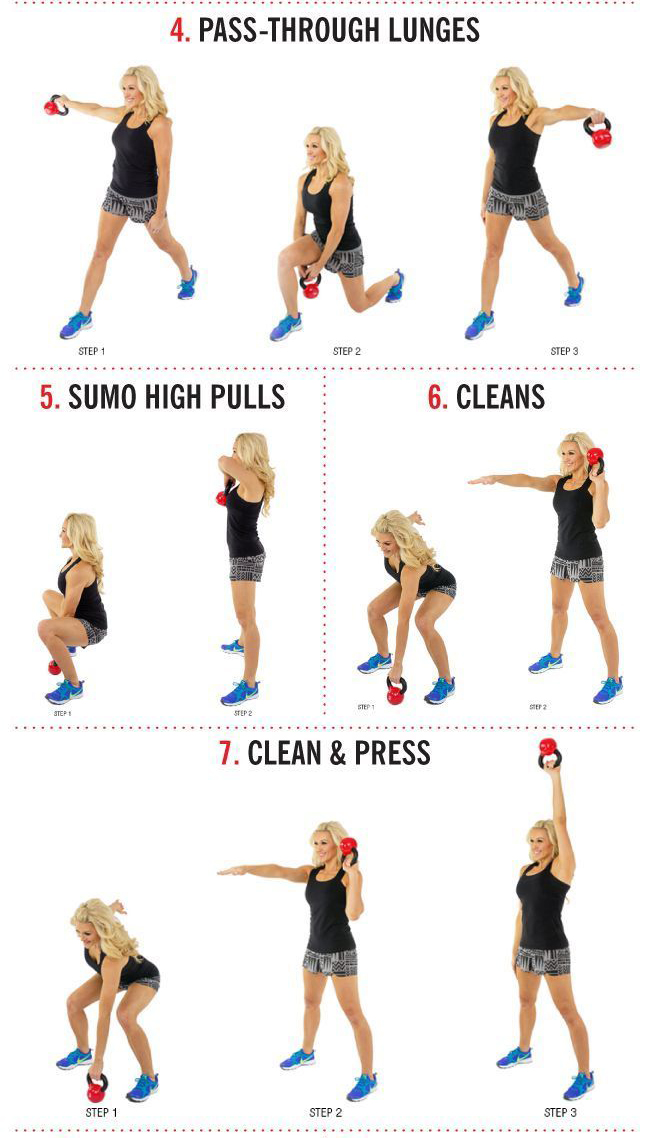14 Kettlebell Calorie Blaster Workouts
Unlike the exercises with dumbbells or barbells, the Kettlebell Calorie Blaster Workouts often involve large numbers of repetitions. Kettlebell exercises are in their nature holistic; therefore they work several muscles simultaneously and may be repeated continuously for several minutes or with short breaks. This combination makes the exercise partially aerobic and more similar to high-intensity interval training rather than to traditional weight lifting.
In one study, kettlebell enthusiasts performing a 20 minute snatch workout were measured to burn, on average, 13.6 calories/minute aerobically and 6.6 calories/minute anaerobically during the entire workout – “equivalent to running a 6-minute mile pace”. Because of their high repetitions, kettlebell progression should start out slowly to build muscle endurance, support the joints and prevent injury.
Get started: Warm up 10 minutes of light cardio to get your body moving. Perform the exercises in order, one move after the other.
Beginners: 2 sets of 15 reps for each move, resting for 45 seconds between moves.
Advance: 3-5 sets of 20 reps for each move; no rest between moves.
1. One Arm Swing: The kettlebell is swung from just below the groin to somewhere between the upper abdomen and shoulders, with arms nearly straight. The key to a good kettlebell swing is effectively thrusting the hips, not bending too much at the knees and sending the weight forwards, as opposed to squatting the weight up, or lifting up with the arms
2. Two Arm Swing: The swing can also be performed with a release and catch of the kettlebell, which helps train the proper swing pattern where the arms aren’t pulling up at the top. This can be done with two hands switching to a supinated catch.
3. Overhead Swing: Also called the overhead swing, this swing variation ends with the kettlebell directly overhead instead of at chest level
4. Pass-Through Lunge: the bell goes down on one side of the body, switching hands and up through the legs, and then down the other side.
5. Sumo High Pull: A swing variation where the kettlebell is thrusted a little higher than the Russian swing, and at the apex the bell is pulled in towards the shoulder, and the pushed out again and back into the swing down.
6. Clean: The clean is often combined with a press or jerk to make a clean and press or a clean & jerk (also called a long jerk). The dead clean is a clean starting with the kettlebell on the floor.
7. Clean and Press: The clean is often combined with a press or jerk to make a clean and press or a clean & jerk (also called a long jerk).
8. Goblet Squat: the goblet position, which can help develop hip mobility by using the elbows to push the knees out at the bottom of the squat.
9. Around The World (waist): move the weight around your waist in a small circle, until you reach the stating position again, Keep kettlebell bottom pointing down when behind you, its bottom points down keep the core braced. Avoid swinging of the upper body and moving your head around the weight.
10. Snatch: The kettlebell is held in one hand, lowered to below the groin, swung to an overhead position and held stable, before repeating the movement. The dead snatch or true snatch begins with the bell on the ground. The lunge snatch lowers into a lunge while the bell goes to the overhead position.
11. Figure Eights: trainee moves the bell in a figure-8 through the legs while in a partial squat.
12. Thruster: A rack squat with a press at the top using momentum from the squat.
13. Renegade Rows: Also called a plank row, the trainee starts in the plank position holding the handles of two grounded kettlebells. One bell is rowed to the chest while maintaining the plank position, then returned to the ground and repeated with the other arm. Alternatively performed with a single kettlebell, one arm at a time.
14. Turkish Get Up: A kettlebell exercise that combines the lunge, bridge and side plank to build strength, the get-up is a slow and controlled movement, unlike the other exercises that have a power or ballistic element. Keeping the arm holding the bell extended vertical, the athlete transitions from laying supine on the floor to standing, and back again.
The movements used in kettlebell exercise can be dangerous to those who have back or shoulder problems, or a weak core. However, if done properly they can also be very beneficial to health. They offer improved mobility, range of motion and increased strength.



